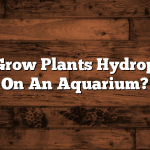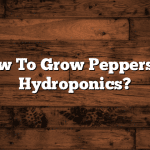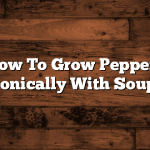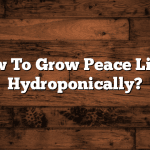Components Needed for Hydroponic System
When setting up a hydroponic system, it is essential to gather all the necessary components to ensure successful and efficient growth of your plants. One of the key components needed is a reservoir to hold the nutrient solution, which provides the essential elements for plant growth. A good-quality reservoir should be made of durable materials such as plastic or fiberglass and have a capacity that matches the size of your hydroponic system. Additionally, you will need a water pump to circulate the nutrient solution throughout the system. It is crucial to choose a pump that is appropriate for the size of your system and has the power to maintain proper circulation.
Another crucial component for a hydroponic system is a grow tray or container. This is where the plants will be placed and supported as they grow. The grow tray should be made of a material that is resistant to water and can withstand the weight of the plants. It is also important to consider the size of the grow tray to ensure that it accommodates the number of plants you wish to grow. Other components required for a hydroponic system include an air pump to provide oxygen for the roots of the plants, a timer to automate the lighting schedule, and pH and nutrient monitors to maintain the optimal conditions for plant growth. By gathering all the necessary components, you can create a well-functioning hydroponic system that promotes the healthy development of your plants.
Choosing the Right Location for Your Hydroponic System
When it comes to setting up a hydroponic system, choosing the right location is crucial for its success. The first consideration should be the availability of sunlight. Since plants need sunlight for photosynthesis, it is important to find a spot that gets at least six to eight hours of direct sunlight each day. If there are obstructions, such as buildings or trees, that cast shadows on the chosen location, it may be necessary to trim them or adjust the position of the system accordingly. Additionally, it is important to ensure that the location is easily accessible for maintenance tasks, such as checking water levels and monitoring plant growth. This will save time and effort in the long run, as regular monitoring and upkeep are essential for optimal growth and productivity.
Another factor to consider when selecting a location for a hydroponic system is the availability of a stable and level surface. The system should be placed on a flat and sturdy surface to prevent any wobbling or tilting, which can lead to uneven water distribution or potential damage to the plants and equipment. This can also affect the stability of the nutrient solution in the reservoir and the proper functioning of the water pump. Moreover, it is crucial to choose a location that is well-ventilated to prevent the build-up of excess humidity and heat. Adequate airflow will not only help maintain the ideal temperature and humidity levels for plant growth but also minimize the risk of diseases and pests. Taking these factors into account when choosing the location for a hydroponic system will set a solid foundation for successful cultivation and higher yields.
Preparing the Growing Medium for Your Hydroponic System
Hydroponic systems have become increasingly popular among home gardeners and commercial growers alike. One of the key components needed for a successful hydroponic system is the growing medium. Unlike traditional soil-based gardening, hydroponics allows plants to grow in a soil-less medium, where nutrients are delivered directly to the roots through a water-based solution.
When it comes to preparing the growing medium for your hydroponic system, there are several options to choose from. Some of the most common growing mediums include perlite, vermiculite, coconut coir, and Rockwool. Each of these mediums has its own advantages and disadvantages, so it’s important to consider factors such as water retention, pH levels, and aeration. Additionally, you’ll want to ensure that the growing medium is clean and free from any pests or diseases that could harm your plants. By taking the time to properly prepare your growing medium, you’ll create an optimal environment for your hydroponic plants to thrive and produce a high yield.
Setting Up the Reservoir for Your Hydroponic System
To ensure the success of your hydroponic system, it is crucial to properly set up the reservoir. This essential component serves as the main storage vessel for the nutrient solution that supplies the plants with the necessary nutrients. When setting up the reservoir, it is important to choose a container that is suitable for hydroponic use and can hold a sufficient amount of water to meet the needs of your plants.
One important consideration when selecting a reservoir is its material. It is recommended to use food-grade plastic containers that are opaque or dark-colored to prevent algae growth. Avoid using containers made of materials that could leach harmful chemicals into the water. Additionally, the size of the reservoir should be determined based on the number of plants in your hydroponic system and their water consumption rates. A larger reservoir might be needed for systems with a higher number of plants or for plants that have a high water demand, while smaller systems may require smaller reservoirs. Always consider the size needed to maintain a stable water temperature and avoid excessive evaporation.
Installing the Water Pump for Your Hydroponic System
To ensure the proper circulation and delivery of water to your plants in a hydroponic system, installing a water pump is essential. The water pump acts as the heart of the system, providing the necessary flow and pressure for nourishing the plants’ roots. Before you begin the installation process, it is crucial to carefully select a pump that meets the specific requirements of your hydroponic system. Consider factors such as the volume of water needed, the pump’s flow rate and pressure capabilities, as well as any additional features that may be necessary for your setup.
Once you have chosen the appropriate water pump, it is time to install it in your hydroponic system. Begin by finding a suitable location for the pump within your setup, ensuring it is easily accessible for maintenance and repairs. It is recommended to place the pump at the bottom of the reservoir to maximize efficiency and minimize the risk of air locks. To secure the pump, use Velcro straps or mounting brackets to prevent any movement or vibration that may lead to damage or noise. Additionally, make sure to connect the pump to a power source that can accommodate its electrical requirements, following all safety precautions to prevent any potential hazards.






